A Review of Logistics Pricing Research Based on Game Theory
Abstract
:1. Introduction
2. Game Theory
- Player: the player of a game is a subject who can choose the appropriate decision to maximize its own utility, which can be an individual or a group, such as a country, an enterprise, an organization, etc. Hereinafter, it is referred to as the participant.
- Strategy: the strategy is the rule by which the participant chooses its own action; the rule will determine what action the participant chooses in what situation.
- Utility function: the utility function is the level of utility that the parties involved in the game can obtain from the game, reflecting the participants’ expectations of the outcome. It is stipulated in economics that utility function must be quantifiable, which can be a continuous function or discrete function. The value of utility can be positive or negative. Each party involved in the game has its own utility function, but they do not necessarily know each other’s utility functions.
3. Research Method
- RQ1:
- What are the main players and key research scenarios in logistics service pricing?
- RQ2:
- Which game models and approaches are the most appropriate for logistics service pricing?
- RQ3:
- What are the main and the most important factors affecting the price of logistics services?
4. Literature Classification and Analysis
4.1. Logistics Scenarios
4.2. Game Methods
4.3. Influencing Factors
5. Review Results
6. Conclusions and Research Implications
Author Contributions
Funding
Institutional Review Board Statement
Informed Consent Statement
Data Availability Statement
Conflicts of Interest
References
- Hsiao, H.; Kemp, R.; van der Vorst, J.; Omta, S. A classification of logistic outsourcing levels and their impact on service performance: Evidence from the food processing industry. Int. J. Prod. Econ. 2010, 124, 75–86. [Google Scholar] [CrossRef]
- Fredriksson, A.; Johansson, E. Integrating logistics into the outsourcing process. Int. J. Logist. Res. Appl. 2009, 12, 281–298. [Google Scholar] [CrossRef]
- Kandil, N.; Battaïa, O.; Hammami, R. Globalisation vs. Slowbalisation: A literature review of analytical models for sourcing decisions in supply chain management. Annu. Rev. Control 2020, 49, 277–287. [Google Scholar] [CrossRef]
- Marasco, A. Third-party logistics: A literature review. Int. J. Prod. Econ. 2008, 113, 127–147. [Google Scholar] [CrossRef]
- Aguezzoul, A. Third-party logistics selection problem: A literature review on criteria and methods. Omega 2014, 49, 69–78. [Google Scholar] [CrossRef]
- Büyüközkan, G.; Feyzioğlu, O.; Ersoy, M. Evaluation of 4PL operating models: A decision making approach based on 2-additive Choquet integral. Int. J. Prod. Econ. 2009, 121, 112–120. [Google Scholar] [CrossRef]
- Liu, Q.; Zhang, C.; Zhu, K.; Rao, Y. Novel multi-objective resource allocation and activity scheduling for fourth party logistics. Comput. Oper. Res. 2014, 44, 42–51. [Google Scholar] [CrossRef]
- Gkanatsas, E.; Krikke, H. Towards a Pro-Silience Framework: A Literature Review on Quantitative Modelling of Resilient 3PL Supply Chain Network Designs. Sustainability 2020, 12, 4323. [Google Scholar] [CrossRef]
- Mankiw, N. Essentials of Economics, 7th ed.; Cengage Learning: Boston, MA, USA, 2014. [Google Scholar]
- Boonmee, C.; Arimura, M.; Asada, T. Facility location optimization model for emergency humanitarian logistics. Int. J. Disaster Risk Reduct. 2017, 24, 485–498. [Google Scholar] [CrossRef]
- Govindan, K.; Soleimani, H.; Kannan, D. Reverse logistics and closed-loop supply chain: A comprehensive review to explore the future. Eur. J. Oper. Res. 2015, 240, 603–626. [Google Scholar] [CrossRef] [Green Version]
- Han, J.-W.; Zuo, M.; Zhu, W.-Y.; Zuo, J.-H.; Lü, E.-L.; Yang, X.-T. A comprehensive review of cold chain logistics for fresh agricultural products: Current status, challenges, and future trends. Trends Food Sci. Technol. 2021, 109, 536–551. [Google Scholar] [CrossRef]
- Chaudhuri, A.; Dukovska-Popovska, I.; Subramanian, N.; Chan, H.K.; Bai, R. Decision-making in cold chain logistics using data analytics: A literature review. Int. J. Logist. Manag. 2018, 29, 839–861. [Google Scholar] [CrossRef] [Green Version]
- Neghabadi, P.D.; Samuel, K.E.; Espinouse, M.-L. Systematic literature review on city logistics: Overview, classification and analysis. Int. J. Prod. Res. 2018, 57, 865–887. [Google Scholar] [CrossRef]
- Lukassen, P.J.; Wallenburg, C.M. Pricing third-party logistics services: Integrating insights from the logistics and industrial services literature. Transp. J. 2010, 49, 24–43. [Google Scholar] [CrossRef]
- Neumann, J.V.; Morgenstern, O. Theory of Games and Economic Behavior; Princeton University Press: Princeton, NJ, USA, 1944. [Google Scholar]
- Tranfield, D.; Denyer, D.; Smart, P. Towards a Methodology for Developing Evidence-Informed Management Knowledge by Means of Systematic Review. Br. J. Manag. 2003, 14, 207–222. [Google Scholar] [CrossRef]
- Meline, T. Selecting studies for systemic review: Inclusion and exclusion criteria. Contemp. Issues Commun. Sci. Disord. CICSD 2006, 33, 21–27. [Google Scholar] [CrossRef]
- Jia, F.; Yin, S.; Chen, L.; Chen, X. The circular economy in the textile and apparel industry: A systematic literature review. J. Clean. Prod. 2020, 259, 120728. [Google Scholar] [CrossRef]
- Mongeon, P.; Paul-Hus, A. The journal coverage of Web of Science and Scopus: A comparative analysis. Scientometrics 2016, 106, 213–228. [Google Scholar] [CrossRef]
- Pokharel, S.; Mutha, A. Perspectives in reverse logistics: A review. Resour. Conserv. Recycl. 2009, 53, 175–182. [Google Scholar] [CrossRef]
- Wang, J.; Liao, J. Researches in the Cooperative Relationship of Manufacturer and TPL. Logistics Research and Practice in China 2008, 306-+. In Proceedings of the International Conference on Logistics Engineering and Supply Chain, Changsha, China, 20–22 August 2008. [Google Scholar]
- Li, F. Outsourcing Pricing Between 3PL and Manufacturer Based on Asymmetric Information. In Proceedings of the 2013 International Conference on Service Sciences (ICSS 2013), Shenzen, China, 11–13 April 2013; pp. 192–195. [Google Scholar]
- Tu, J.; Sun, Z.; Huang, M. Supply Chain Coordination Considering E-Tailer’s Promotion Effort and Logistics Provider’s Service Effort. J. Ind. Manag. Optim. 2022, 18, 2191–2220. [Google Scholar] [CrossRef]
- Song, Z.; Wang, X. Contract coordination for green logistics capabilities involving the logistics service demand side. Environ. Eng. Manag. J. 2020, 19, 1519–1533. [Google Scholar]
- Bao, F.; Chen, D.; Miao, H.; Chen, Y. TPL service level and pricing models in manufacturer-retailer supply chains. In Proceedings of the 2010 International Conference on Management of e-Commerce and e-Government, Washington, DC, USA, 7–9 May 2010; pp. 333–337. [Google Scholar]
- Zhao, L.; Tang, L. Service pricing strategy for third party logistics corporations implementing VMI. In Proceedings of the 2007 IEEE International Conference on Industrial Engineering and Engineering Management, Singapore, 2–4 December 2007; pp. 1442–1446. [Google Scholar]
- Gong, Y.D. Analysis on collaborative strategy of TPL-SC led by TPL service provider. In Proceedings of the 21st Annual International Conference on Chinese Control and Decision Conference, Guilin, China, 17–19 June 2009; Volume 1–6, pp. 6045–6049. [Google Scholar] [CrossRef]
- Chen, X.; Xu, P.; Walker, T.; Huang, S. Pricing and Ordering Decisions in a Retailer Dominant Channel Involving a Third-Party Logistics Provider. Complexity 2019, 2019, 1954016. [Google Scholar] [CrossRef] [Green Version]
- Zhang, C.; Fan, L.-W.; Tian, Y.-X. Optimal operational strategies of capital-constrained supply chain with logistics service and price dependent demand under 3PL financing service. Soft Comput. 2019, 24, 2793–2806. [Google Scholar] [CrossRef]
- Lei, L.; Wang, Q.; Fan, C. Optimal business policies for a supplier–transporter–buyer channel with a price-sensitive demand. J. Oper. Res. Soc. 2006, 57, 281–289. [Google Scholar] [CrossRef] [Green Version]
- Du, F.; Ang, S.; Yang, F.; Yang, C. Price and distribution range of logistics service providers considering market competition. Asia Pac. J. Mark. Logist. 2018, 30, 762–778. [Google Scholar] [CrossRef]
- Liu, Y. EMS Cooperative Pricing Mechanism Optimization for Electronic Commerce. In Proceedings of the 3rd International Conference on Intelligent Transportation, Big Data and Smart City, ICITBS, Xiamen, China, 25–26 January 2018; pp. 420–423. [Google Scholar] [CrossRef]
- Li, W.; He, X.; Nie, K. Pricing decision research for TPL considering different logistics service level influencing the market demand. J. Ind. Eng. Manag. 2013, 1, 267–275. [Google Scholar] [CrossRef]
- Guo, M.; Zhu, J.; Zhao, X. A bi-level programming model for supplier selection in constructing logistics service supply chain. In Proceedings of the 2007 IEEE International Conference on Industrial Engineering and Engineering Management, Singapore, 2–5 December 2007; Volume 1–4, pp. 1614–1618. [Google Scholar]
- Zhao, H.; Lin, B.; Mao, W.; Ye, Y. Differential Game Analyses of Logistics Service Supply Chain Coordination by Cost Sharing Contract. J. Appl. Math. 2014, 2014, 842409. [Google Scholar] [CrossRef] [Green Version]
- Liu, W.; Wang, D.; Tang, O.; Zhu, D. The impacts of logistics service integrator’s overconfidence behaviour on supply chain decision under demand surge. Eur. J. Ind. Eng. 2018, 12, 558–597. [Google Scholar] [CrossRef]
- Liu, W.; Yan, X.; Wei, W.; Xie, D.; Wang, D. Altruistic preference for investment decisions in the logistics service supply chain. Eur. J. Ind. Eng. 2018, 12, 598–635. [Google Scholar] [CrossRef]
- Liu, W.; Wang, M.; Zhu, D.; Zhou, L. Service capacity procurement of logistics service supply chain with demand updating and loss-averse preference. Appl. Math. Model. 2018, 66, 486–507. [Google Scholar] [CrossRef]
- Xu, Q.; Han, M. Profit Distribution of Low-Carbon Logistics Service Supply Chain Based on Social Responsibility. In Proceedings of the 11th International Conference on Logistics and Systems Engineering, Changsha City, China, 11–12 March 2022; pp. 324–339. [Google Scholar]
- Wang, D.; Liu, W.; Liang, Y. Green innovation in logistics service supply chain: The impacts of relationship strength and overconfidence. Ann. Oper. Res. 2022, 1–31. [Google Scholar] [CrossRef]
- Wang, S.; Hu, Z.H. Green logistics service supply chain games considering risk preference in fuzzy environments. Sustainability 2021, 13, 8024. [Google Scholar] [CrossRef]
- Zhang, J.; Song, Z. Decision Optimization of Four-Level Supply Chain with the Participation of Two-Echelon Logistics Service Providers under Different Power Structures. Math. Probl. Eng. 2021, 2021, 5518840. [Google Scholar] [CrossRef]
- Du, N.; Han, Q. Pricing and Service Quality Guarantee Decisions in Logistics Service Supply Chain with Fairness Concern. Asia-Pac. J. Oper. Res. 2018, 35, 18500367. [Google Scholar] [CrossRef]
- Zhang, T.; Qu, T.; Huang, G.Q.; Chen, X.; Wang, Z. Sizing, pricing and common replenishment in a headquarter-managed centralized distribution center. Ind. Manag. Data Syst. 2016, 116, 1086–1104. [Google Scholar] [CrossRef]
- Zhong, Y.; Guo, F.; Tang, H.; Chen, X. Research on Coordination Complexity of E-Commerce Logistics Service Supply Chain. Complexity 2020, 2020, 7031543. [Google Scholar] [CrossRef]
- Mo, H.; Chen, Q. Dynamic Game Analysis on Logistic Service in China. In Proceedings of the 2008 4th IEEE International Conference on Wireless Communications, Networking and Mobile Computing Dalian, China, 12–17 October 2008; Volume 1–31, pp. 6465–6470. [Google Scholar]
- Wen, X.; Xu, X.; Choi, T.M.; Chung, S.H. Optimal pricing decisions of competing air-cargo-carrier systems—Impacts of risk aversion, demand, and cost uncertainties. IEEE Trans. Syst. Man Cybern. Syst. 2019, 50, 4933–4947. [Google Scholar] [CrossRef]
- Watada, J.; Waripan, T.; Wu, B. Optimal decision methods in two-echelon logistic models. Manag. Decis. 2014, 52, 1273–1287. [Google Scholar] [CrossRef]
- Lin, P.C.; Nureize, A. Two-echelon logistic model based on game theory with fuzzy variable. Adv. Intell. Syst. Comput. 2014, 287, 325–334. [Google Scholar]
- Niu, B.; Dai, Z.; Liu, Y.; Jin, Y. The role of Physical Internet in building trackable and sustainable logistics service supply chains: A game analysis. Int. J. Prod. Econ. 2022, 247, 108438. [Google Scholar] [CrossRef]
- Ma, M.; Zhang, F.; Liu, W.; Dixit, V. A game theoretical analysis of metro-integrated city logistics systems. Transp. Res. Part B Methodol. 2022, 156, 14–27. [Google Scholar] [CrossRef]
- Tamannaei, M.; Zarei, H.; Rasti-Barzoki, M. A game theoretic approach to sustainable freight transportation: Competition between road and intermodal road–rail systems with government intervention. Transp. Res. Part B Methodol. 2021, 153, 272–295. [Google Scholar] [CrossRef]
- Tamannaei, M.; Zarei, H.; Aminzadegan, S. A Game-Theoretic Approach to the Freight Transportation Pricing Problem in the Presence of Intermodal Service Providers in a Competitive Market. Netw. Spat. Econ. 2021, 21, 123–173. [Google Scholar] [CrossRef]
- Qiu, X.; Lam, J.S.L. Optimal Storage Pricing and Pickup Scheduling for Inbound Containers in a Dry Port System. In Proceedings of the 2014 IEEE International Conference on Systems, Man and Cybernetics (SMC), San Diego, CA, USA, 5–8 October 2014; pp. 2959–2964. [Google Scholar]
- Park, B.; Min, H. A game-theoretic approach to evaluating the competitiveness of container carriers in the Northeast Asian shipping market. Asia Pac. J. Mark. Logist. 2017, 29, 854–869. [Google Scholar] [CrossRef]
- Feng, X.; Yan, Y. Strategy choice of port logistics enterprises in price war. J. Traffic Transp. Eng. 2005, 5, 113–116. [Google Scholar]
- Han, X.; Bai, S.; Yu, H. Pre-Sale Strategy for Fresh Agricultural Products Under the Consideration of Logistics Services. IEEE Access 2021, 9, 127742–127752. [Google Scholar] [CrossRef]
- Song, Z.; He, S.; Xu, G. Decision and coordination of fresh produce three-layer e-commerce supply chain: A new framework. IEEE Access 2019, 7, 30465–30486. [Google Scholar] [CrossRef]
- Zhang, Y.; Rong, F.; Wang, Z. Research on cold chain logistic service pricing-based on tripartite Stackelberg game. Neural Comput. Appl. 2020, 32, 213–222. [Google Scholar] [CrossRef]
- Song, Z.; He, S. Contract coordination of new fresh produce three-layer supply chain. Ind. Manag. Data Syst. 2019, 119, 148–169. [Google Scholar] [CrossRef]
- De, A.; Singh, S.P. Analysis of Competitiveness in Agri-Supply Chain Logistics Outsourcing: A B2B Contractual Framework. Sustainability 2022, 14, 6866. [Google Scholar] [CrossRef]
- De, A.; Singh, S.P. A resilient pricing and service quality level decision for fresh agri-product supply chain in post-COVID-19 era. Int. J. Logist. Manag. 2021. [Google Scholar] [CrossRef]
- Jiang, Y.M.; Mou, J.J. Joint decisions for Cold Chain Cross-border E-commerce with Overseas Warehouse Logistics Outsourcing. In E3S Web of Conferences; EDP Sciences: Les Ulis, France, 2021; Volume 261, p. 03033. [Google Scholar]
- Wang, M.; Zhao, L.; Herty, M. Joint replenishment and carbon trading in fresh food supply chains. Eur. J. Oper. Res. 2019, 277, 561–573. [Google Scholar] [CrossRef]
- Fan, L. The Research on 4PL Optimal Pricing Strategy Based on the Reverse Logistics Integration. In Proceedings of the 5th International Conference on Innovation and Management, Maastricht, The Netherlands, 10–11 December 2008; Volume 1–2, pp. 1408–1412. [Google Scholar]
- Hosseini-Motlagh, S.-M.; Nematollahi, M.; Nami, N. Drug recall management and channel coordination under stochastic product defect severity: A game-Theoretic analytical study. Int. J. Prod. Res. 2020, 59, 1649–1675. [Google Scholar] [CrossRef]
- Zhao, X.F.; Zhao, X.M. Pricing Decision and Performance Analysis of Closed-loop Supply Chain with Third-Party Reverse Logistics. In Proceedings of the International Conference on Management and Service Science, Bangkok, Thailand, 7–9 May 2011; p. 5998244. [Google Scholar] [CrossRef]
- Chen, X.-X.; Xu, P.; Li, J.-J.; Walker, T.; Yang, G.-Q. Decision-making in a retailer-led closed-loop supply chain involving a third-party logistics provider. J. Ind. Manag. Optim. 2022, 18, 1161. [Google Scholar] [CrossRef]
- Giri, B.C.; Chakraborty, A.; Maiti, T. Pricing and return product collection decisions in a closed-loop supply chain with dual-channel in both forward and reverse logistics. J. Manuf. Syst. 2017, 42, 104–123. [Google Scholar] [CrossRef]
- Jafari, H.; Hejazi, S.R.; Rasti-Barzoki, M. Sustainable development by waste recycling under a three-echelon supply chain: A game-theoretic approach. J. Clean. Prod. 2017, 142, 2252–2261. [Google Scholar] [CrossRef]
- Feng, D.; Yu, X.; Mao, Y.; Ding, Y.; Zhang, Y.; Pan, Z. Pricing Decision for Reverse Logistics System under Cross-Competitive Take-Back Mode Based on Game Theory. Sustainability 2019, 11, 6984. [Google Scholar] [CrossRef] [Green Version]
- Wang, W.; Wang, H.; Jiang, S. Surge Pricing Optimization of Crowdsourcing Logistics Service Based on Sharing Economy. In Proceedings of the 2019 International Conference on Industrial Engineering and Systems Management (IESM 2019), Shanghai, China, 25–27 September 2019; pp. 359–364. [Google Scholar]
- Wang, W.; Xie, L. Optimal pricing of crowdsourcing logistics services with social delivery capacity. J. Comb. Optim. 2021, 43, 1447–1469. [Google Scholar] [CrossRef]
- Ji, S.W.; Feng, Q.; Wang, Y.Z.; Wang, X.S. The research on pricing customizing services of logistics information platform. In Advanced Materials Research; Trans Tech Publications Ltd.: Bäch, Switzerland, 2013; Volume 774, pp. 2004–2007. [Google Scholar] [CrossRef]
- Qin, L.; Juan, H. A model of price determining in Intelligent System of logistics cloud-network. In Proceedings of the 2013 Fifth International Conference on Measuring Technology and Mechatronics Automation (ICMTMA 2013), Hong Kong, China, 16–17 January 2013; pp. 37–40. [Google Scholar]
- Yu, Z.Z.; Ji, S.W. The Two-Step Pricing Strategy Research of Regional Logistics Information Platform Based on Game Theory. Adv. Mater. Res. 2013, 655–657, 2274–2278. [Google Scholar] [CrossRef]
- Hou, R.; Li, L.; Lin, X.; Zha, Y.; Zhao, Y. Pricing strategy for logistics service platforms with competition and user distance preference. Int. Trans. Oper. Res. 2021, 28, 3437–3469. [Google Scholar] [CrossRef]
- Tawfik, C.; Limbourg, S. Pricing Problems in Intermodal Freight Transport: Research Overview and Prospects. Sustainability 2018, 10, 3341. [Google Scholar] [CrossRef] [Green Version]
- Ji, S.X.; Ye, N.Y.; Lv, H.Y. Game analyses on deciding the price of logistics service based-on customer satisfaction. In Proceedings of the 8th International Conference of Chinese Logistics and Transportation Professionals, Chengdu, China, 8–10 October 2008; pp. 268–274. [Google Scholar] [CrossRef]

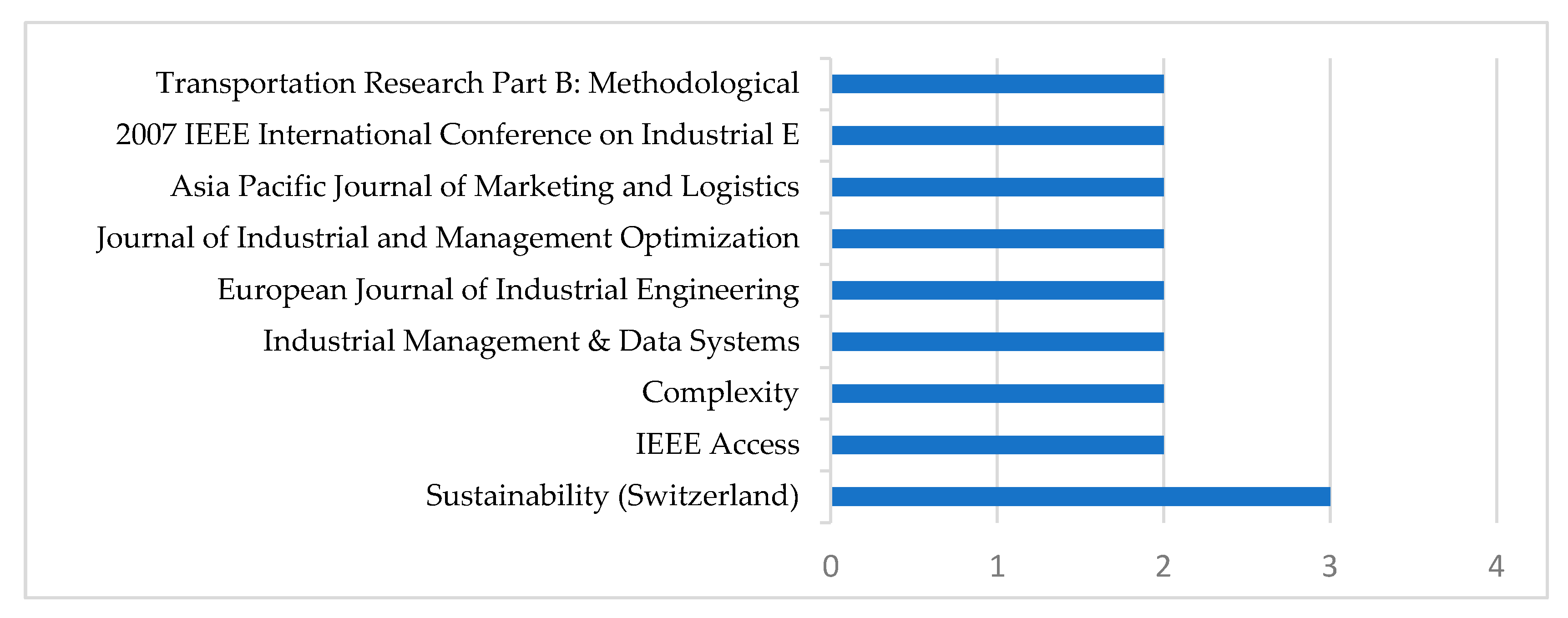
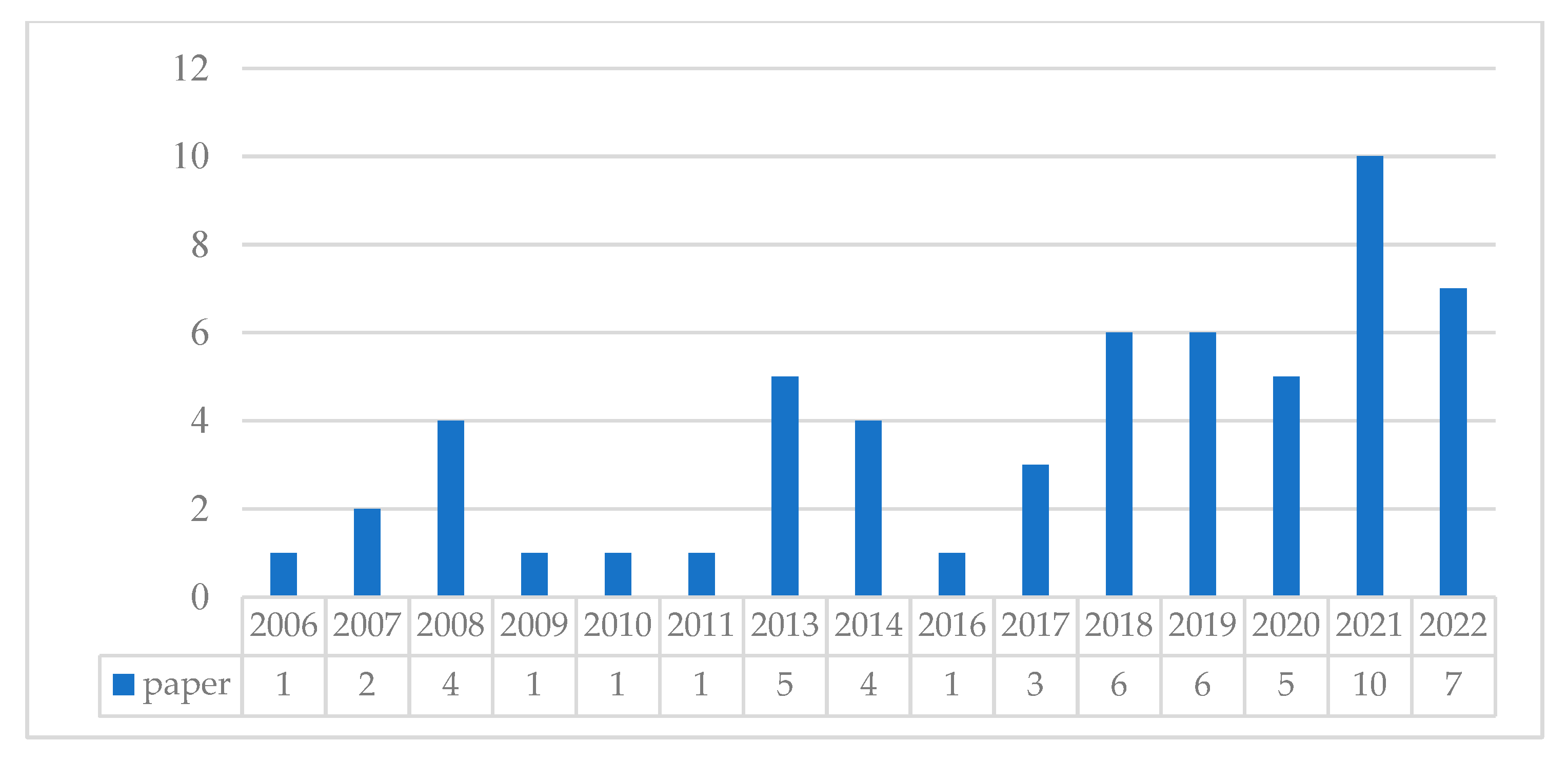
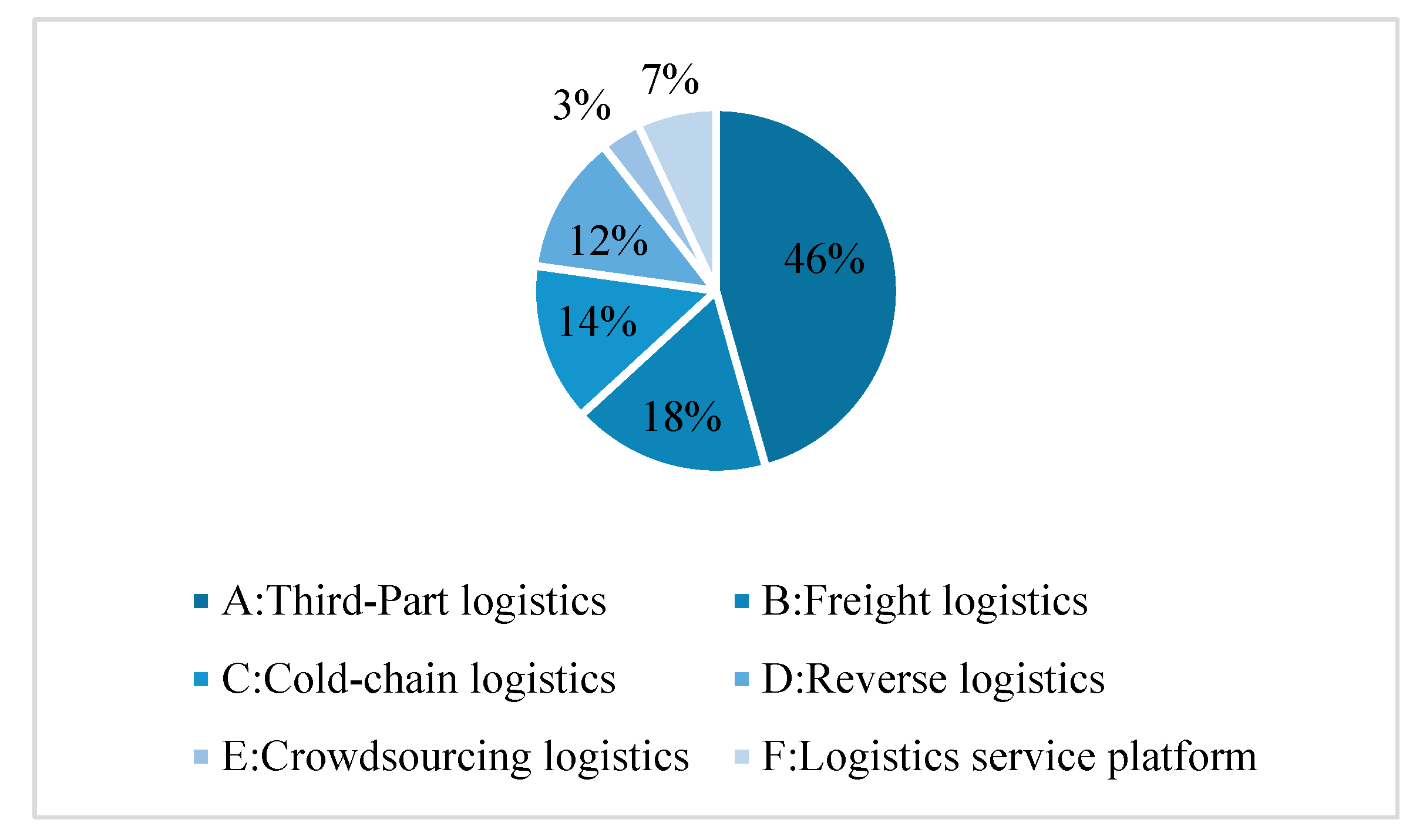

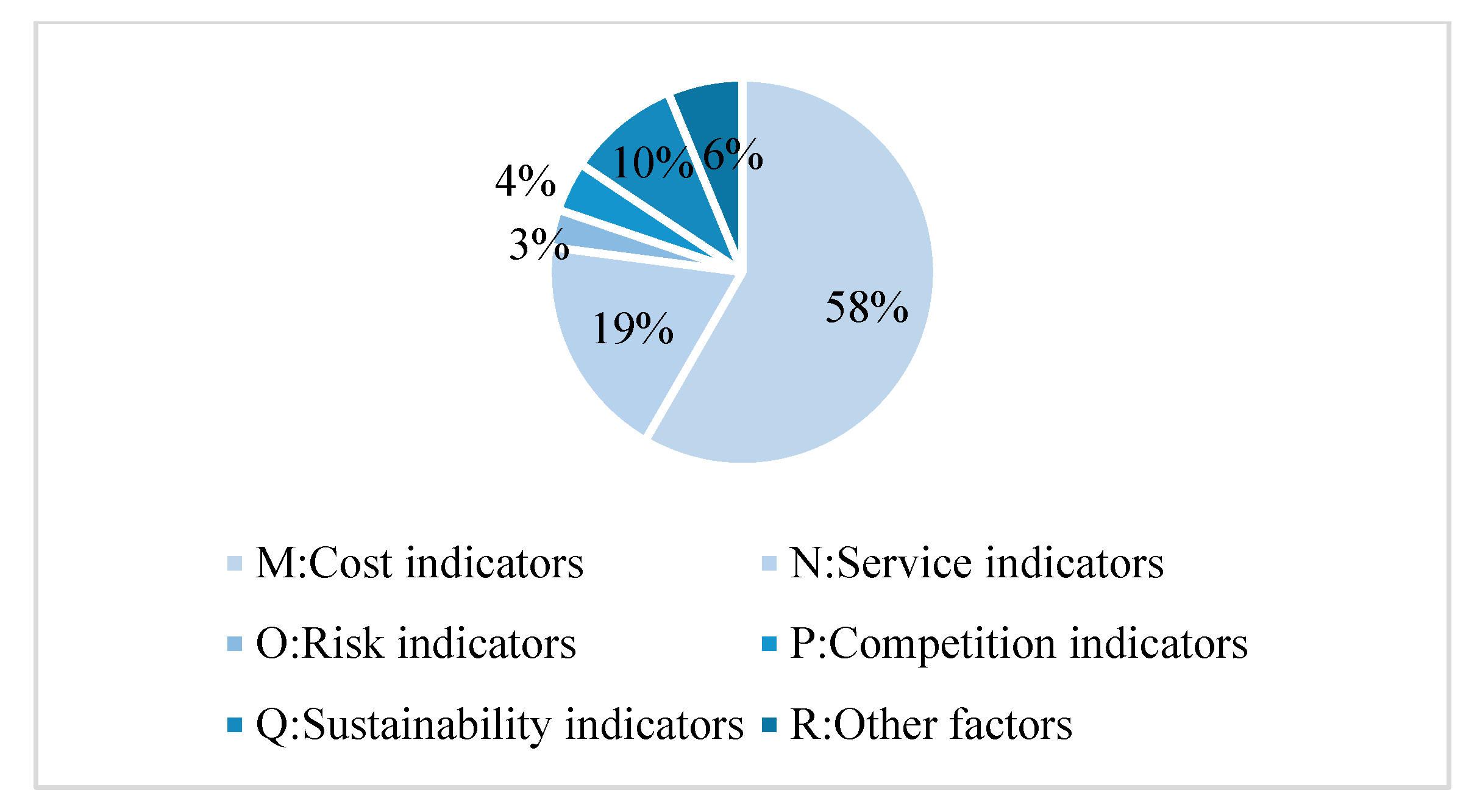

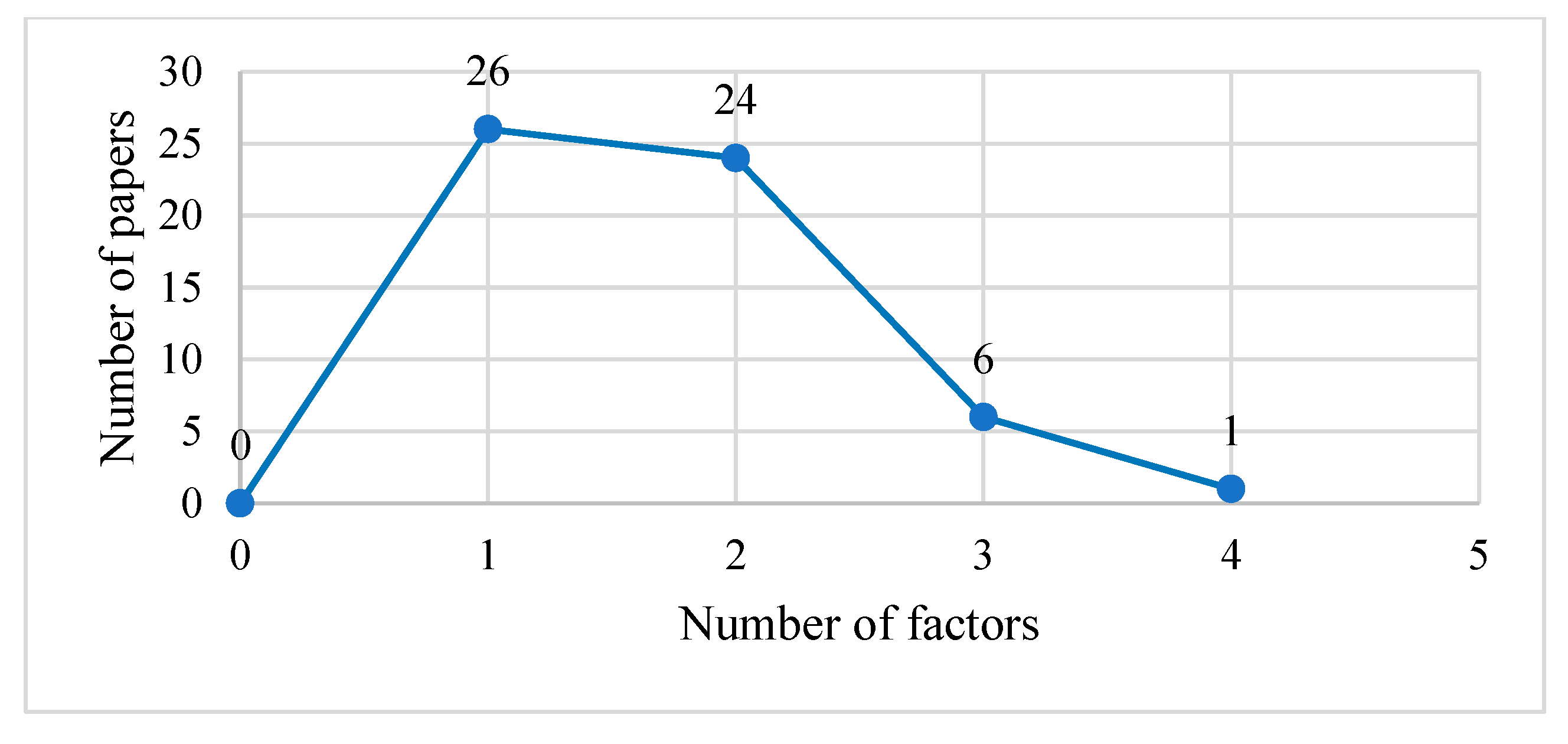

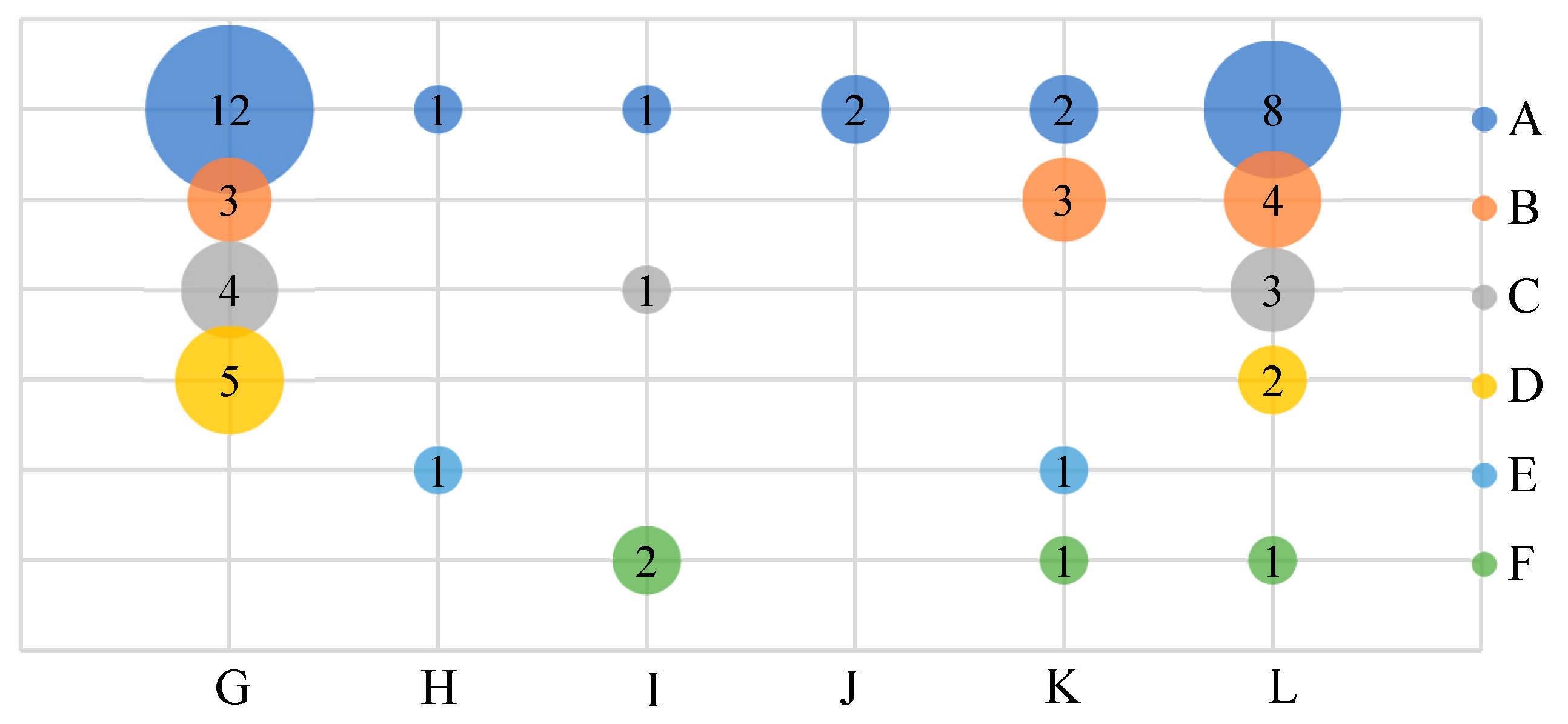
| Inclusion Criteria | Exclusion Criteria |
|---|---|
| Full journal and conference proceedings | Lectures, grey literature, presentations, policy documents |
| English language | Non-English language |
| Peer-reviewed | Not peer-reviewed |
| The method of game theory is used to study logistics pricing | The paper only mentions logistics, game theory or price as one of the important aspects, but does not carry out specific analysis and research |
| Logistics price is a decision variable, which is endogenous to the system. | Logistics price is an exogenous variable. |
Publisher’s Note: MDPI stays neutral with regard to jurisdictional claims in published maps and institutional affiliations. |
© 2022 by the authors. Licensee MDPI, Basel, Switzerland. This article is an open access article distributed under the terms and conditions of the Creative Commons Attribution (CC BY) license (https://creativecommons.org/licenses/by/4.0/).
Share and Cite
Kong, J.; Chen, Z.; Liu, X. A Review of Logistics Pricing Research Based on Game Theory. Sustainability 2022, 14, 10520. https://doi.org/10.3390/su141710520
Kong J, Chen Z, Liu X. A Review of Logistics Pricing Research Based on Game Theory. Sustainability. 2022; 14(17):10520. https://doi.org/10.3390/su141710520
Chicago/Turabian StyleKong, Jili, Ziyu Chen, and Xiaoping Liu. 2022. "A Review of Logistics Pricing Research Based on Game Theory" Sustainability 14, no. 17: 10520. https://doi.org/10.3390/su141710520
APA StyleKong, J., Chen, Z., & Liu, X. (2022). A Review of Logistics Pricing Research Based on Game Theory. Sustainability, 14(17), 10520. https://doi.org/10.3390/su141710520






